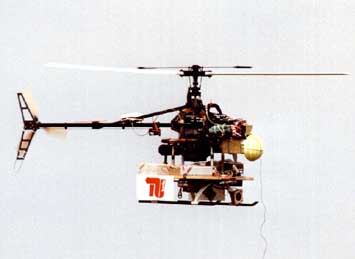| TU
Berlin Department of Computer Science |
 |
Institute
for Technical Computer Science Real Time Systems & Robotics |
| TU
Berlin Department of Computer Science |
 |
Institute
for Technical Computer Science Real Time Systems & Robotics |

| This page outlines the technical conception of the autonomously flying robot MARVIN. MARVIN is based on a model helicopter and designed for participation in the IARC'1998-2000 (International Aerial Robotics Competetion) of the AUVSI (Association for Unmanned Vehicle Systems International). In this competition flying robots are supposed to scan an unknown area for target objects, which have to classified according to movement or symbols. The required computational power can be provided in a ground station as far as data transmission is wireless. |
| Robot | System Overview | Sensors | Communication | Ground Station | Onboard Computer |
| 1 Robot |
The basis of MARVIN is a usual model helicopter with a 23 cm3 two-stroke gasoline engine. It has a rotor diameter of 1.8 m and an empty weight of 6.5 kg. Maximum payload is about 5 kg. |
| 3 Sensors |
|
|
| 4 Communication |
|
|
| 5 Ground Station |
|
The ground station runs the vision software for evaluating the camera images from the robot and the "Mission Control" software. The latter maintains a virtual map of the competition arena and transmits intended flight courses to the robot. The flight paths are planned according to an object list containing intended photo positions and potential objects that should be further investigated. An additional task of the ground station is passing the GPS reference data from the ground receiver to the robot. |
| 6 Onboard Computer |
|
The computer board has been designed and manufactured in the MARVIN project course in cooperation with the board manufacturing laboratory of the "Technische Fachhochschule Berlin" (TFH). Based on the GPS reference data and the onboard sensors, the onboard computer is able to autonomously follow a given intended course. The helicopter servos are driven directly by the controller. A new "command" from the ground station is not required as long as the intended course remains unchanged. |
| back to MARVIN's homepage | next topic |
| Last update 18.01.2000 by Marek Musial | Real Time Systems & Robotics |